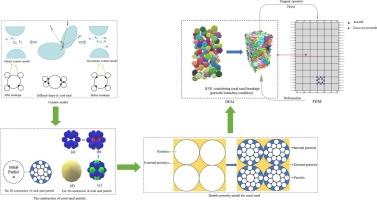Multiscale simulation study for mechanical characteristics of coral sand influenced by particle breakage
IF 4.5
2区 工程技术
Q2 ENGINEERING, CHEMICAL
引用次数: 0
Abstract
This paper investigates the mechanical response of coral sand under particle breakage using a hierarchical multiscale model combining the discrete element method (DEM) and the finite element method (FEM). This DEM-FEM model links the microscopic interaction mechanisms to macroscopic phenomena such as strain localization and failure. A cohesive contact model was first utilized to simulate compaction bands in the DEM and construct a cohesive assembly with smaller particles distributed around a larger particle to better simulate the grinding and angular breakage of coral sand. A representative volume element (RVE) that includes particle breakage was then constructed and analyzed under periodic boundary conditions. DEM analysis was performed, and the results were compared with triaxial compression test data obtained from the literature, demonstrating that the constructed RVE effectively represents the mechanical properties of coral sand. The constructed RVE was used for hierarchical multiscale simulations, which showed good agreement with existing triaxial testing of coral sand. Finally, by setting a larger cohesive force, the constructed coral sand particles were prevented from breakage, and comparative analysis revealed that particle breakage weakens the mechanical properties of coral sand. Furthermore, different shapes of coral sand particles were constructed, and RVE and hierarchical multiscale simulations of triaxial tests were performed. The results indicated that the triaxial tests of long strip-shaped coral sand particles exhibit higher peak values compared to spherical coral sand particles. Additionally, a double porosity model of coral sand was constructed to analyze the impact of internal porosity on soil mechanical properties. The results showed that the presence of internal porosity significantly weakened the mechanical properties of coral sand. These findings highlight the significant impact of particle breakage and shape on the mechanical behavior of coral sand, offering important insights for engineering applications.

受颗粒破碎影响的珊瑚砂力学特性的多尺度模拟研究
本文采用离散元素法(DEM)和有限元法(FEM)相结合的分层多尺度模型,研究了珊瑚砂在颗粒破碎情况下的机械响应。该 DEM-FEM 模型将微观相互作用机制与应变局部化和破坏等宏观现象联系起来。首先利用内聚接触模型模拟 DEM 中的压实带,并构建一个由分布在较大颗粒周围的较小颗粒组成的内聚组件,以更好地模拟珊瑚砂的研磨和角断裂。然后,在周期性边界条件下,构建并分析了包含颗粒破碎的代表性体积元素(RVE)。进行了 DEM 分析,并将分析结果与从文献中获得的三轴压缩试验数据进行了比较,结果表明构建的 RVE 有效地代表了珊瑚砂的力学特性。构建的 RVE 被用于分层多尺度模拟,与现有的珊瑚砂三轴测试结果显示出良好的一致性。最后,通过设置较大的内聚力,防止所构建的珊瑚砂颗粒破裂,对比分析表明,颗粒破裂会削弱珊瑚砂的力学性能。此外,还构建了不同形状的珊瑚砂颗粒,并对三轴试验进行了 RVE 和分层多尺度模拟。结果表明,与球形珊瑚砂颗粒相比,长条形珊瑚砂颗粒的三轴试验表现出更高的峰值。此外,还构建了珊瑚砂的双孔隙度模型,以分析内部孔隙度对土壤力学性能的影响。结果表明,内部孔隙率的存在大大削弱了珊瑚砂的力学性能。这些发现凸显了颗粒破碎和形状对珊瑚砂机械行为的重要影响,为工程应用提供了重要启示。
本文章由计算机程序翻译,如有差异,请以英文原文为准。
求助全文
约1分钟内获得全文
求助全文
来源期刊

Powder Technology
工程技术-工程:化工
CiteScore
9.90
自引率
15.40%
发文量
1047
审稿时长
46 days
期刊介绍:
Powder Technology is an International Journal on the Science and Technology of Wet and Dry Particulate Systems. Powder Technology publishes papers on all aspects of the formation of particles and their characterisation and on the study of systems containing particulate solids. No limitation is imposed on the size of the particles, which may range from nanometre scale, as in pigments or aerosols, to that of mined or quarried materials. The following list of topics is not intended to be comprehensive, but rather to indicate typical subjects which fall within the scope of the journal's interests:
Formation and synthesis of particles by precipitation and other methods.
Modification of particles by agglomeration, coating, comminution and attrition.
Characterisation of the size, shape, surface area, pore structure and strength of particles and agglomerates (including the origins and effects of inter particle forces).
Packing, failure, flow and permeability of assemblies of particles.
Particle-particle interactions and suspension rheology.
Handling and processing operations such as slurry flow, fluidization, pneumatic conveying.
Interactions between particles and their environment, including delivery of particulate products to the body.
Applications of particle technology in production of pharmaceuticals, chemicals, foods, pigments, structural, and functional materials and in environmental and energy related matters.
For materials-oriented contributions we are looking for articles revealing the effect of particle/powder characteristics (size, morphology and composition, in that order) on material performance or functionality and, ideally, comparison to any industrial standard.
 求助内容:
求助内容: 应助结果提醒方式:
应助结果提醒方式:


